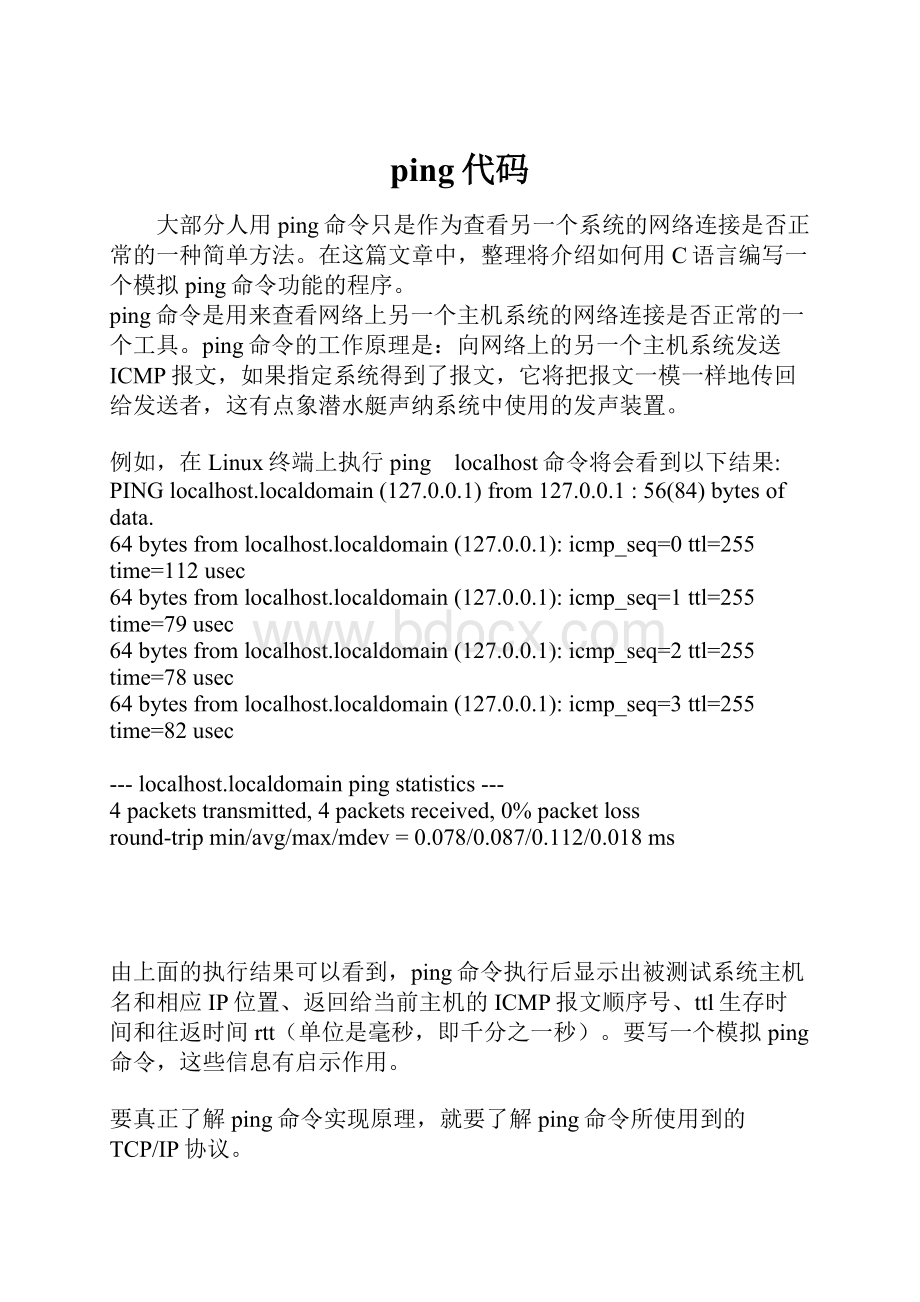ping代码.docx
《ping代码.docx》由会员分享,可在线阅读,更多相关《ping代码.docx(13页珍藏版)》请在冰豆网上搜索。

ping代码
大部分人用ping命令只是作为查看另一个系统的网络连接是否正常的一种简单方法。
在这篇文章中,整理将介绍如何用C语言编写一个模拟ping命令功能的程序。
ping命令是用来查看网络上另一个主机系统的网络连接是否正常的一个工具。
ping命令的工作原理是:
向网络上的另一个主机系统发送ICMP报文,如果指定系统得到了报文,它将把报文一模一样地传回给发送者,这有点象潜水艇声纳系统中使用的发声装置。
例如,在Linux终端上执行ping localhost命令将会看到以下结果:
PINGlocalhost.localdomain(127.0.0.1)from127.0.0.1:
56(84)bytesofdata.
64bytesfromlocalhost.localdomain(127.0.0.1):
icmp_seq=0ttl=255time=112usec
64bytesfromlocalhost.localdomain(127.0.0.1):
icmp_seq=1ttl=255time=79usec
64bytesfromlocalhost.localdomain(127.0.0.1):
icmp_seq=2ttl=255time=78usec
64bytesfromlocalhost.localdomain(127.0.0.1):
icmp_seq=3ttl=255time=82usec
---localhost.localdomainpingstatistics---
4packetstransmitted,4packetsreceived,0%packetloss
round-tripmin/avg/max/mdev=0.078/0.087/0.112/0.018ms
由上面的执行结果可以看到,ping命令执行后显示出被测试系统主机名和相应IP位置、返回给当前主机的ICMP报文顺序号、ttl生存时间和往返时间rtt(单位是毫秒,即千分之一秒)。
要写一个模拟ping命令,这些信息有启示作用。
要真正了解ping命令实现原理,就要了解ping命令所使用到的TCP/IP协议。
ICMP(InternetControlMessage,网际控制报文协议)是为网关和目标主机而提供的一种差错控制机制,使它们在遇到差错时能把错误报告给报文源发方。
ICMP协议是IP层的一个协议,但是由于差错报告在发送给报文源发方时可能也要经过若干子网,因此牵涉到路由选择等问题,所以ICMP报文需通过IP协议来发送。
ICMP数据报的数据发送前需要两级封装:
首先添加ICMP报头形成ICMP报文,再添加IP报头形成IP数据报。
如下图所示
IP报头
ICMP报头
ICMP数据报
IP报头格式
由于IP层协议是一种点对点的协议,而非端对端的协议,它提供无连接的数据报服务,没有端口的概念,因此很少使用bind()和connect()函数,若有使用也只是用于设置IP位置。
发送数据使用sendto()函数,接收数据使用recvfrom()函数。
IP报头格式如下图:
在Linux中,IP报头格式数据结构()定义如下:
structip
{
#if__BYTE_ORDER==__LITTLE_ENDIAN
unsignedintip_hl:
4;/*headerlength*/
unsignedintip_v:
4;/*version*/
#endif
#if__BYTE_ORDER==__BIG_ENDIAN
unsignedintip_v:
4;/*version*/
unsignedintip_hl:
4;/*headerlength*/
#endif
u_int8_tip_tos;/*typeofservice*/
u_shortip_len;/*totallength*/
u_shortip_id;/*identification*/
u_shortip_off;/*fragmentoffsetfield*/
#defineIP_RF0x8000/*reservedfragmentflag*/
#defineIP_DF0x4000/*dontfragmentflag*/
#defineIP_MF0x2000/*morefragmentsflag*/
#defineIP_OFFMASK0x1fff/*maskforfragmentingbits*/
u_int8_tip_ttl;/*timetolive*/
u_int8_tip_p;/*protocol*/
u_shortip_sum;/*checksum*/
structin_addrip_src,ip_dst;/*sourceanddestaddress*/
};
其中ping程序只使用以下数据:
IP报头长度IHL(InternetHeaderLength)――以4字节为一个单位来记录IP报头的长度,是上述IP数据结构的ip_hl变量。
生存时间TTL(TimeToLive)――以秒为单位,指出IP数据报能在网络上停留的最长时间,其值由发送方设定,并在经过路由的每一个节点时减一,当该值为0时,数据报将被丢弃,是上述IP数据结构的ip_ttl变量。
ICMP报头格式
ICMP报文分为两种,一是错误报告报文,二是查询报文。
每个ICMP报头均包含类型、编码和校验和这三项内容,长度为8位,8位和16位,其余选项则随ICMP的功能不同而不同。
Ping命令只使用众多ICMP报文中的两种:
"请求回送"(ICMP_ECHO)和"请求回应"(ICMP_ECHOREPLY)。
在Linux中定义如下:
#defineICMP_ECHO0
#defineICMP_ECHOREPLY8
这两种ICMP类型报头格式如下:
在Linux中ICMP数据结构()定义如下:
structicmp
{
u_int8_ticmp_type;/*typeofmessage,seebelow*/
u_int8_ticmp_code;/*typesubcode*/
u_int16_ticmp_cksum;/*onescomplementchecksumofstruct*/
union
{
u_charih_pptr;/*ICMP_PARAMPROB*/
structin_addrih_gwaddr;/*gatewayaddress*/
structih_idseq/*echodatagram*/
{
u_int16_ticd_id;
u_int16_ticd_seq;
}ih_idseq;
u_int32_tih_void;
/*ICMP_UNREACH_NEEDFRAG--PathMTUDiscovery(RFC1191)*/
structih_pmtu
{
u_int16_tipm_void;
u_int16_tipm_nextmtu;
}ih_pmtu;
structih_rtradv
{
u_int8_tirt_num_addrs;
u_int8_tirt_wpa;
u_int16_tirt_lifetime;
}ih_rtradv;
}icmp_hun;
#defineicmp_pptricmp_hun.ih_pptr
#defineicmp_gwaddricmp_hun.ih_gwaddr
#defineicmp_idicmp_hun.ih_idseq.icd_id
#defineicmp_seqicmp_hun.ih_idseq.icd_seq
#defineicmp_voidicmp_hun.ih_void
#defineicmp_pmvoidicmp_hun.ih_pmtu.ipm_void
#defineicmp_nextmtuicmp_hun.ih_pmtu.ipm_nextmtu
#defineicmp_num_addrsicmp_hun.ih_rtradv.irt_num_addrs
#defineicmp_wpaicmp_hun.ih_rtradv.irt_wpa
#defineicmp_lifetimeicmp_hun.ih_rtradv.irt_lifetime
union
{
struct
{
u_int32_tits_otime;
u_int32_tits_rtime;
u_int32_tits_ttime;
}id_ts;
struct
{
structipidi_ip;
/*optionsandthen64bitsofdata*/
}id_ip;
structicmp_ra_addrid_radv;
u_int32_tid_mask;
u_int8_tid_data[1];
}icmp_dun;
#defineicmp_otimeicmp_dun.id_ts.its_otime
#defineicmp_rtimeicmp_dun.id_ts.its_rtime
#defineicmp_ttimeicmp_dun.id_ts.its_ttime
#defineicmp_ipicmp_dun.id_ip.idi_ip
#defineicmp_radvicmp_dun.id_radv
#defineicmp_maskicmp_dun.id_mask
#defineicmp_dataicmp_dun.id_data
};
使用宏定义令表达更简洁,其中ICMP报头为8字节,数据报长度最大为64K字节。
校验和算法――这一算法称为网际校验和算法,把被校验的数据16位进行累加,然后取反码,若数据字节长度为奇数,则数据尾部补一个字节的0以凑成偶数。
此算法适用于IPv4、ICMPv4、IGMPV4、ICMPv6、UDP和TCP校验和,更详细的信息请参考RFC1071,校验和字段为上述ICMP数据结构的icmp_cksum变量。
标识符――用于唯一标识ICMP报文,为上述ICMP数据结构的icmp_id宏所指的变量。
顺序号――ping命令的icmp_seq便由这里读出,代表ICMP报文的发送顺序,为上述ICMP数据结构的icmp_seq宏所指的变量。
ICMP数据报
Ping命令中需要显示的信息,包括icmp_seq和ttl都已有实现的办法,但还缺rtt往返时间。
为了实现这一功能,可利用ICMP数据报携带一个时间戳。
使用以下函数生成时间戳:
#include
intgettimeofday(structtimeval*tp,void*tzp)
其中timeval结构如下:
structtimeval{
longtv_sec;
longtv_usec;
}
其中tv_sec为秒数,tv_usec微秒数。
在发送和接收报文时由gettimeofday分别生成两个timeval结构,两者之差即为往返时间,即ICMP报文发送与接收的时间差,而timeval结构由ICMP数据报携带,tzp指针表示时区,一般都不使用,赋NULL值。
数据统计
系统自带的ping命令当它接送完所有ICMP报文后,会对所有发送和所有接收的ICMP报文进行统计,从而计算ICMP报文丢失的比率。
为达此目的,定义两个全局变量:
接收计数器和发送计数器,用于记录ICMP报文接受和发送数目。
丢失数目=发送总数-接收总数,丢失比率=丢失数目/发送总数。
现给出模拟Ping程序功能的代码如下:
/***********************************************************
*整理:
梁俊辉*
*时间:
2001年10月*
*名称:
myping.c*
*说明:
本程序用于演示ping命令的实现原理*
***********************************************************/
#include
#include
#include
#include
#include
#include
#include
#include
#include
#include
#include
#include
#definePACKET_SIZE4096
#defineMAX_WAIT_TIME5
#defineMAX_NO_PACKETS3
charsendpacket[PACKET_SIZE];
charrecvpacket[PACKET_SIZE];
intsockfd,datalen=56;
intnsend=0,nreceived=0;
structsockaddr_indest_addr;
pid_tpid;
structsockaddr_infrom;
structtimevaltvrecv;
voidstatistics(intsigno);
unsignedshortcal_chksum(unsignedshort*addr,intlen);
intpack(intpack_no);
voidsend_packet(void);
voidrecv_packet(void);
intunpack(char*buf,intlen);
voidtv_sub(structtimeval*out,structtimeval*in);
voidstatistics(intsigno)
{printf("\n--------------------PINGstatistics-------------------\n");
printf("%dpacketstransmitted,%dreceived,%%%dlost\n",nsend,nreceived,
(nsend-nreceived)/nsend*100);
close(sockfd);
exit
(1);
}
/*校验和算法*/
unsignedshortcal_chksum(unsignedshort*addr,intlen)
{intnleft=len;
intsum=0;
unsignedshort*w=addr;
unsignedshortanswer=0;
/*把ICMP报头二进制数据以2字节为单位累加起来*/
while(nleft>1)
{sum+=*w++;
nleft-=2;
}
/*若ICMP报头为奇数个字节,会剩下最后一字节。
把最后一个字节视为一个2字节数据的高字节,这个2字节数据的低字节为0,继续累加*/
if(nleft==1)
{*(unsignedchar*)(&answer)=*(unsignedchar*)w;
sum+=answer;
}
sum=(sum>>16)+(sum&0xffff);
sum+=(sum>>16);
answer=~sum;
returnanswer;
}
/*设置ICMP报头*/
intpack(intpack_no)
{inti,packsize;
structicmp*icmp;
structtimeval*tval;
icmp=(structicmp*)sendpacket;
icmp->icmp_type=ICMP_ECHO;
icmp->icmp_code=0;
icmp->icmp_cksum=0;
icmp->icmp_seq=pack_no;
icmp->icmp_id=pid;
packsize=8+datalen;
tval=(structtimeval*)icmp->icmp_data;
gettimeofday(tval,NULL);/*记录发送时间*/
icmp->icmp_cksum=cal_chksum((unsignedshort*)icmp,packsize);/*校验算法*/
returnpacksize;
}
/*发送三个ICMP报文*/
voidsend_packet()
{intpacketsize;
while(nsend
{nsend++;
packetsize=pack(nsend);/*设置ICMP报头*/
if(sendto(sockfd,sendpacket,packetsize,0,
(structsockaddr*)&dest_addr,sizeof(dest_addr))<0)
{perror("sendtoerror");
continue;
}
sleep
(1);/*每隔一秒发送一个ICMP报文*/
}
}
/*接收所有ICMP报文*/
voidrecv_packet()
{intn,fromlen;
externinterrno;
signal(SIGALRM,statistics);
fromlen=sizeof(from);
while(nreceived
{alarm(MAX_WAIT_TIME);
if((n=recvfrom(sockfd,recvpacket,sizeof(recvpacket),0,
(structsockaddr*)&from,&fromlen))<0)
{if(errno==EINTR)continue;
perror("recvfromerror");
continue;
}
gettimeofday(&tvrecv,NULL);/*记录接收时间*/
if(unpack(recvpacket,n)==-1)continue;
nreceived++;
}
}
/*剥去ICMP报头*/
intunpack(char*buf,intlen)
{inti,iphdrlen;
structip*ip;
structicmp*icmp;
structtimeval*tvsend;
doublertt;
ip=(structip*)buf;
iphdrlen=ip->ip_hl<<2;/*求ip报头长度,即ip报头的长度标志乘4*/
icmp=(structicmp*)(buf+iphdrlen);/*越过ip报头,指向ICMP报头*/
len-=iphdrlen;/*ICMP报头及ICMP数据报的总长度*/
if(len<8)/*小于ICMP报头长度则不合理*/
{printf("ICMPpackets\'slengthislessthan8\n");
return-1;
}
/*确保所接收的是我所发的的ICMP的回应*/
if((icmp->icmp_type==ICMP_ECHOREPLY)&&(icmp->icmp_id==pid))
{tvsend=(structtimeval*)icmp->icmp_data;
tv_sub(&tvrecv,tvsend);/*接收和发送的时间差*/
rtt=tvrecv.tv_sec*1000+tvrecv.tv_usec/1000;/*以毫秒为单位计算rtt*/
/*显示相关信息*/
printf("%dbytefrom%s:
icmp_seq=%uttl=%drtt=%.3fms\n",
len,
inet_ntoa(from.sin_addr),
icmp->icmp_seq,
ip->ip_ttl,
rtt);
}
elsereturn-1;
}
main(intargc,char*argv[])
{structhostent*host;
structprotoent*protocol;
unsignedlonginaddr=0l;
intwaittime=MAX_WAIT_TIME;
intsize=50*1024;
if(argc<2)
{printf("usage:
%shostname/IPaddress\n",argv[0]);
exit
(1);
}
if((protocol=getprotobyname("icmp"))==NULL)
{perror("getprotobyname");
exit
(1);
}
/*生成使用ICMP的原始套接字,这种套接字只有root才能生成*/
if((sockfd=socket(AF_INET,SOCK_RAW,protocol->p_proto))<0)
{perror("socketerror");
exit
(1);
}
/*回收root权限,设置当前用户权限*/
setuid(getuid());
/*扩大套接字接收缓冲区到50K这样做主要为了减小接收缓冲区溢出的
的可能性,若无意中ping一个广播位置或多播位置,将会引来大量应答*/
setsockopt(sockfd,SOL_SOCKET,SO_RCVBUF,&size,sizeof(size));
bzero(&dest_addr,sizeof(dest_addr));
dest_addr.sin_family=AF_INET;
/*判断是主机名还是ip位置*/
if(inaddr=inet_addr(argv[1])==INADDR_NONE)
{if((host=gethostbyname(argv[1]))==NULL)/*是主机名*/
{perror("gethostbynameerror");
exit
(1);
}
memcpy((char*)&dest_addr.sin_addr,host->h_addr,host->h_length);